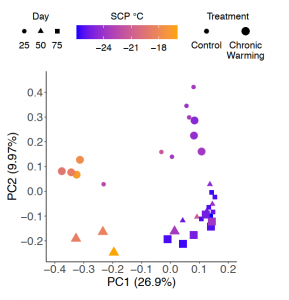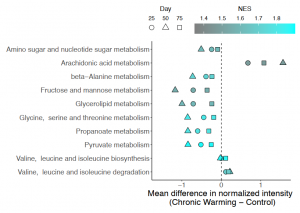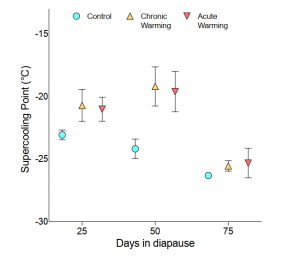Local thermal environment and warming influence supercooling and drive widespread shifts in the metabolome of diapausing Pieris rapae butterflies
Posted on: 11 August 2021 , updated on: 12 August 2021
Preprint posted on 3 July 2021
Warming Alert! Winter warming may hamper diapause of cabbage white butterfly pupae by affecting their supercooling point and metabolomics. For details: https://doi.org/10.1101/2020.06.29.178087
Selected by Fouzia HaiderCategories: ecology, molecular biology
Background
As compared to the other seasons, winter is the most impacted by climate change in terms of higher mean temperatures and fewer days below the freezing point. This is particularly detrimental to organisms that go dormant during winter (diapause). During diapause, overwintering organisms endure the cold using a ‘supercooling’ method, where the temperature of their body fluids drops below 0°C without forming ice, offering an effective strategy to avoid freezing. Diapause is supported by several drivers, both internal (ice binding protein formation, cryoprotective dehydration) and external (temperature). Therefore, an increase in external temperature during winter or of their internal supercooling points can negatively affect the diapause of these organisms, and hence disrupt their life-cycle. Many insects are vulnerable to winter warming, and this is reflected in the evidence of local adaptation of cold tolerance in several species according to their local thermal environment.
Various studies have investigated the relationship between thermal environment and overwintering physiology in a targeted manner, such as by studying the effect of temperature on cryoprotectant metabolites. Although targeting specific metabolites provides us with important discoveries by regarding the molecular basis of diapause and overwintering physiology of insects, it also comes with ascertainment bias. To avoid this bias and understand the influence of temperature on the general metabolome and supercooling process, the authors of this preprint studied the thermal effects on supercooling points and metabolome on two different populations (Vermont and North Carolina) of North American Pieris rapae (cabbage white butterflies). They investigated the effect of acute (hours) and chronic (weeks) increase in temperature on supercooling, and the effect of chronic temperature increase on untargeted metabolomics in P. rapae. They also correlated metabolomics to supercooling.
The thermal exposure was designed as follows: for the control group, a daily fluctuation of 4 – 8°C was administered, the chronic group was exposed to 7 – 11°C (to mimic the local winter warming pattern noticed from 1940 till 2020) and acute group was exposed to 4 – 8°C (as the control group) with 24-hour warming events of fluctuating 18 – 23°C on days 25, 50 and 75 days (to mimic the recorded high local winter temperatures). The authors compared the supercooling points of (1) Vermont vs. North Carolina populations (under control conditions), (2) Vermont control vs. Vermont chronic warmed, and (3) Vermont control vs. Vermont acute warmed. Metabolomics were only investigated in the Vermont population between control and chronic warming groups.
Results
The supercooling point of P. rapae pupae was lower in the Vermont population (-26.3 ± 0.3°C) compared to the North Carolina population (-19.8 ± 4.0°C), which corresponds to the extreme low in local temperature (approximately -26°C and -15°C, respectively). Both chronic and acute temperature increase caused a higher supercooling point on day 50 in diapause. This effect was not observed on day 75 in diapause (Fig. 1; used per authors’ consent).
Figure 1: Effect of chronic and acute winter warming on the supercooling points of Vermont population of Pieris rapae pupae.
Diapause caused significant changes to the abundance of 1,370 metaboites, of which 443 responded significantly to chronic warming and 16 changed significantly in response to diapause and warming. Principal component analysis showed that supercooling point explains the largest variation (27%), while the second major axis of variation is the days of diapause (10%) (Fig. 2; used per authors’ consent).

Figure 2: Principal Component analysis (PCA) of whole metabolomics of Pieris rapae pupae. The first component (PC1) is supercooling point which explains 26.9% of variation and the second component (PC2) is the days in diapause which explains 9.97%. The shapes of the points depict days in diapause, the size of the points depicts temperature treatment and the color shade depicts supercooling points.
Chronic warming showed significantly increased enrichment in 1 biochemical pathway, and significantly decreased enrichment in 7 others (Fig. 3; used per authors’ consent). The increase was observed in arachidonate metabolism, indicating that winter warming could affect the usage of energy storage. The pathways demonstrating a decrease in response to chronic warming are well-known cryoprotectants – ß-alanine metabolism, fructose and mannose metabolism, and glycine, serine and threonine metabolism.

Fig. 3: Effect of winter warming on different biochemical pathways in Pieris rapae pupae. Positive value in X axis indicates higher abundance and negative values indicate lower abundances of metabolites relative to control group. The shape of the points depicts days in diapause and the color shade depicts normalized enrichment score (NES).
What I like about this preprint
The authors of this preprint highlighted a crucial biological process being impacted by global warming: diapause in organisms that undergo a metabolic depression during winter. Temperature is an important external factor moderating diapause in these organisms, and winter warming could affect their diapause, and life cycle. This could occur by affecting the supercooling point of these organisms or by altering other physiological mechanisms, such as biochemical pathways. Although previous research has focused on certain metabolites under different circumstances, this study took an untargeted approach to understand the effect of winter warming on metabolomics. Thus, we can identify, biochemical pathway(s) that have been otherwise overlooked.
doi: https://doi.org/10.1242/prelights.30315
Read preprintSign up to customise the site to your preferences and to receive alerts
Register hereAlso in the ecology category:
Gestational exposure to high heat-humidity conditions impairs mouse embryonic development
Girish Kale, preLights peer support
Blue appendages and temperature acclimation increase survival during acute heat stress in the upside-down jellyfish, Cassiopea xamachana
Maitri Manjunath
How the liver contributes to stomach warming in the endothermic white shark Carcharodon carcharias
Sarah Young-Veenstra
Also in the molecular biology category:
Cell cycle-dependent mRNA localization in P-bodies
Mohammed JALLOH
Notch3 is a genetic modifier of NODAL signalling for patterning asymmetry during mouse heart looping
Bhaval Parmar
Fetal brain response to maternal inflammation requires microglia
Manuel Lessi
preLists in the ecology category:
preLights peer support – preprints of interest
This is a preprint repository to organise the preprints and preLights covered through the 'preLights peer support' initiative.
| List by | preLights peer support |
EMBO | EMBL Symposium: The organism and its environment
This preList contains preprints discussed during the 'EMBO | EMBL Symposium: The organism and its environment', organised at EMBL Heidelberg, Germany (May 2023).
| List by | Girish Kale |
Bats
A list of preprints dealing with the ecology, evolution and behavior of bats
| List by | Baheerathan Murugavel |
Also in the molecular biology category:
BSCB-Biochemical Society 2024 Cell Migration meeting
This preList features preprints that were discussed and presented during the BSCB-Biochemical Society 2024 Cell Migration meeting in Birmingham, UK in April 2024. Kindly put together by Sara Morais da Silva, Reviews Editor at Journal of Cell Science.
| List by | Reinier Prosee |
‘In preprints’ from Development 2022-2023
A list of the preprints featured in Development's 'In preprints' articles between 2022-2023
| List by | Alex Eve, Katherine Brown |
CSHL 87th Symposium: Stem Cells
Preprints mentioned by speakers at the #CSHLsymp23
| List by | Alex Eve |
9th International Symposium on the Biology of Vertebrate Sex Determination
This preList contains preprints discussed during the 9th International Symposium on the Biology of Vertebrate Sex Determination. This conference was held in Kona, Hawaii from April 17th to 21st 2023.
| List by | Martin Estermann |
Alumni picks – preLights 5th Birthday
This preList contains preprints that were picked and highlighted by preLights Alumni - an initiative that was set up to mark preLights 5th birthday. More entries will follow throughout February and March 2023.
| List by | Sergio Menchero et al. |
CellBio 2022 – An ASCB/EMBO Meeting
This preLists features preprints that were discussed and presented during the CellBio 2022 meeting in Washington, DC in December 2022.
| List by | Nadja Hümpfer et al. |
EMBL Synthetic Morphogenesis: From Gene Circuits to Tissue Architecture (2021)
A list of preprints mentioned at the #EESmorphoG virtual meeting in 2021.
| List by | Alex Eve |
FENS 2020
A collection of preprints presented during the virtual meeting of the Federation of European Neuroscience Societies (FENS) in 2020
| List by | Ana Dorrego-Rivas |
ECFG15 – Fungal biology
Preprints presented at 15th European Conference on Fungal Genetics 17-20 February 2020 Rome
| List by | Hiral Shah |
ASCB EMBO Annual Meeting 2019
A collection of preprints presented at the 2019 ASCB EMBO Meeting in Washington, DC (December 7-11)
| List by | Madhuja Samaddar et al. |
Lung Disease and Regeneration
This preprint list compiles highlights from the field of lung biology.
| List by | Rob Hynds |
MitoList
This list of preprints is focused on work expanding our knowledge on mitochondria in any organism, tissue or cell type, from the normal biology to the pathology.
| List by | Sandra Franco Iborra |












 (No Ratings Yet)
(No Ratings Yet)